Protocol - Alcohol - Lifetime Use
- Alcohol - 30-Day Quantity and Frequency
- Alcohol - Age of First Use
- Alcohol - Maximum Drinks in 24 Hours
- Substance Abuse and Dependence - Past Year - Alcohol
- Substance Abuse and Dependence - Past Year - Drugs
- Substance Abuse and Dependence - Past Year - Tobacco
Description
Measurement of whether respondent has ever consumed alcohol.
Specific Instructions
Alcohol is defined as any type of alcohol (including coolers, beer, wine, champagne) and liquor (e.g., whiskey, rum, gin, vodka, scotch, or liqueurs).
Availability
This protocol is freely available; permission not required for use.
Protocol
The Working Group acknowledges that the following question may gather sensitive information relating to the use of substances and/or illegal conduct. If the information is released it might be damaging to an individual’s employability, lead to social stigmatization, or other consequences.
For information on obtaining a Certificate of Confidentiality, which helps researchers protect the privacy of human research participants, please go to the National Human Genome Research Institute’s Institutional Review Board website.
The following question is asked of the respondent. Respondents answer yes or no to this question. Read the introductory paragraph to the respondent. If your questionnaire includes multiple questions about alcohol, then the first sentence should be "The next questions are about drinking alcohol."
The next question is about drinking alcohol. This includes coolers, beer, wine, champagne, liquor such as whiskey, rum, gin, vodka, scotch, or liqueurs, and also any other type of alcohol.
In your entire life, have you had at least 1 drink of any kind of alcohol, not counting small tastes or sips?
1[ ]Yes
2[ ]No
Notes to interviewer:
- Definition of a standard drink: 1 12oz bottle of beer, 1 glass 4oz non-fortified wine, 1 mixed drink with 1oz liquor.
- If respondent needs a visual reference for the size of a drink, the flashcards from the Wave 1 National Epidemiologic Survey on Alcohol and Related Conditions (NESARC) study are provided below:
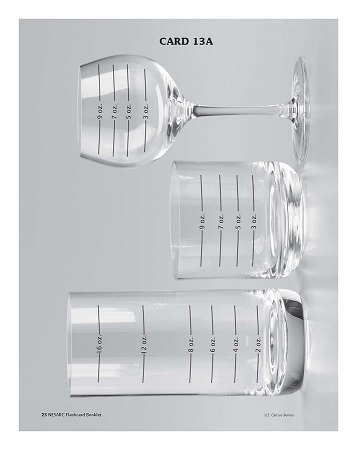
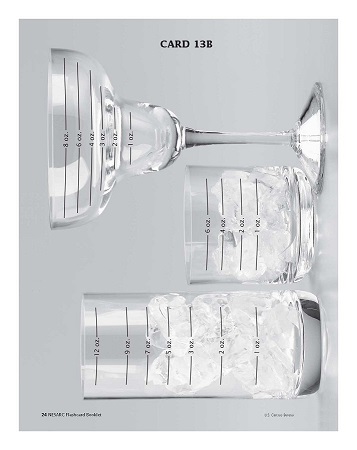

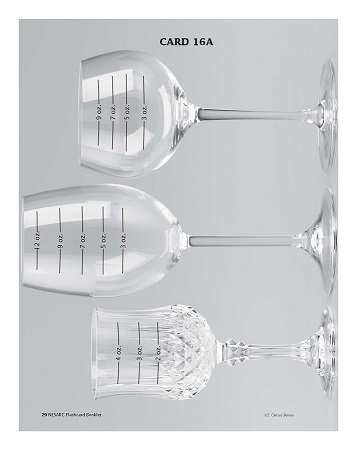
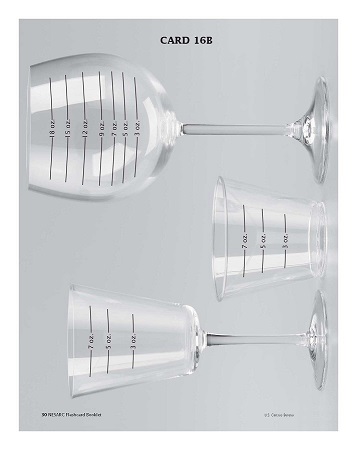
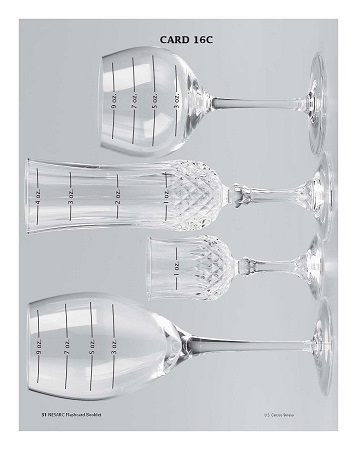

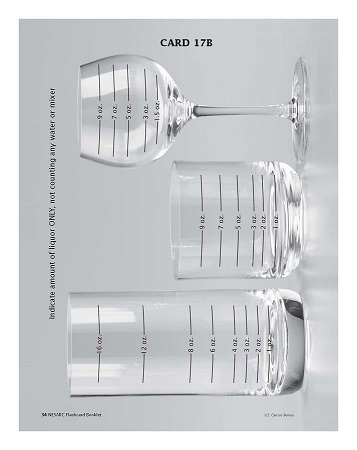
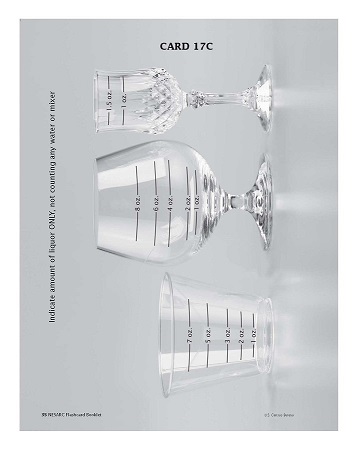
Personnel and Training Required
Interviewer must be trained and found to be competent to conduct personal interviews with individuals from the general population. The interviewer should be trained to prompt respondents further if a "don’t know" response is provided.
Equipment Needs
While the Alcohol Use Disorder and Associated Disabilities Interview Schedule-IV (AUDADIS-IV) instrument was developed for administration by computer, the PhenX Working Group acknowledges that this question can be administered in a noncomputerized format. Hasin et al. (1997) and Grant et al. (1995) used the AUDADIS in paper-and-pencil format, while Grant et al. (2003) obtained data with the computerized format.
Requirements
| Requirement Category | Required |
|---|---|
| Major equipment | No |
| Specialized training | No |
| Specialized requirements for biospecimen collection | No |
| Average time of greater than 15 minutes in an unaffected individual | No |
Mode of Administration
Interviewer-administered questionnaire
Lifestage
Adult
Participants
≥18 years of age
Selection Rationale
The protocol from the Alcohol Use Disorder and Associated Disabilities Interview Schedule (AUDADIS) was chosen because it was used in a large epidemiological study of adults of a wide age range and different ethnicities (Wave 1 included 43,093 Americans; in Wave 2, 34,653 members of the original cohort were reinterviewed). The measures from this survey have been validated and psychometrically tested.
Language
Chinese, English, Other languages available at source
Standards
| Standard | Name | ID | Source |
|---|---|---|---|
| Logical Observation Identifiers Names and Codes (LOINC) | Alcohol lifetime use proto | 62543-4 | LOINC |
| Human Phenotype Ontology | Alcoholism | HP:0030955 | HPO |
| caDSR Form | PhenX PX030101 - Alcohol Lifetime Use | 5806376 | caDSR Form |
Derived Variables
None
Process and Review
The Expert Review Panel #3 (ERP 3) reviewed the measures in Alcohol, Tobacco and Other Substances, and Substance Abuse and Addiction domains.
Guidance from ERP 3 includes:
• No significant changes to measure
Back-compatible: NA no changes to Data Dictionary
Previous version in Toolkit archive (link)
Protocol Name from Source
National Epidemiologic Survey on Alcohol and Related Conditions (NESARC), Wave 1
Source
National Institute on Alcohol Abuse and Alcoholism (NIAAA) National Epidemiologic Survey on Alcohol and Related Conditions. Wave 1 (NESARC - WAVE 1). Alcohol Use Disorder and Associated Disabilities Interview Schedule - Diagnostic and Statistical Manual of Mental Disorders. Fourth Edition Version (AUDADIS-IV). Section 2A. Question 1 and Flashcard Booklet, Flashcards 13A-C, 16A-C, and 17A-C.
Grant, B. F., Dawson, D. A., Stinson, F. S., Chou, P. S., Kay, W., & Pickering, R. (2003) The Alcohol Use Disorder and Associated Disabilities Interview Schedule-IV (AUDADIS-IV): Reliability of alcohol consumption, tobacco use, family history of depression and psychiatric diagnostic modules in a general population sample. Drug and Alcohol Dependence, 71(1), 7-16.
General References
Grant, B. F., Dawson, D. A., Stinson, F. S., Chou, P. S., Kay, W., & Pickering R. (2003). The Alcohol Use Disorder and Associated Disabilities Interview Schedule-IV (AUDADIS-IV): Reliability of alcohol consumption, tobacco use, family history of depression and psychiatric diagnostic modules in a general population sample. Drug and Alcohol Dependence, 71(1), 7-16.
Grant, B. F., Harford, T. C., Dawson, D. A., Chou, P. S., & Pickering, R. P. (1995). The Alcohol Use Disorder and Associated Disabilities Interview Schedule (AUDADIS): Reliability of alcohol and drug modules in a general population sample. Drug and Alcohol Dependence, 39(1), 37-44.
Hasin, D., Carpenter, K. M., McCloud, S., Smith, M., & Grant, B. F. (1997). The Alcohol Use Disorder and Associated Disabilities Interview Schedule (AUDADIS): Reliability of alcohol and drug modules in a clinical sample. Drug and Alcohol Dependence, 44(2-3), 133-141.
For information regarding alcohol consumption among women who are pregnant, please refer to the Centers for Disease Control and Prevention (CDC) National Center on Birth Defects & Developmental Disabilities Fetal Alcohol Syndrome website, the CDC Behavioral Risk Factor Surveillance System website, and the CDC Pregnancy Risk Assessment Monitoring System (PRAMS) website.
Protocol ID
30101
Variables
Export Variables| Variable Name | Variable ID | Variable Description | dbGaP Mapping | |
|---|---|---|---|---|
| PX030101_Lifetime_Use | ||||
| PX030101010000 | In your entire life, have you had at least 1 more | N/A | ||
Measure Name
Alcohol - Lifetime Use
Release Date
February 6, 2009
Definition
Question asking the respondent if s/he has ever consumed any alcoholic beverage during his or her entire life.
Purpose
This measure can be used to assess the participant’s lifetime exposure to alcohol. The question is often used as a prelude to more detailed questions about alcohol use to screen out individuals who have ever consumed alcohol.
Keywords
alcohol, alcohol exposure, alcohol use, alcohol abuse, alcohol use, coolers, beer, wine, champagne, liquor, whiskey, rum, gin, vodka, scotch, liqueurs, sherry, cocktail, mixed drink, National Institute on Alcohol Abuse and Alcoholism, NIAAA, National Epidemiologic Survey on Alcohol and Related Conditions, NESARC, Alcohol Use Disorder and Associated Disabilities Interview Schedule, AUDADIS, Diagnostic and Statistical Manual of Mental Disorders, National Survey on Drug Use and Health, NSDUH, gerontology, aging, geriatrics
Measure Protocols
| Protocol ID | Protocol Name |
|---|---|
| 30101 | Alcohol - Lifetime Use |